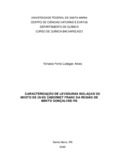| dc.contributor.advisor | Penna, Neidi Garcia | |
| dc.creator | Alves, Yohana Porto Calegari | |
| dc.date.accessioned | 2020-10-23T23:00:00Z | |
| dc.date.available | 2020-10-23T23:00:00Z | |
| dc.date.issued | 2020-08-21 | |
| dc.date.submitted | 2020 | |
| dc.identifier.uri | http://repositorio.ufsm.br/handle/1/20096 | |
| dc.description | Trabalho de conclusão de curso (graduação) - Universidade Federal de Santa Maria, Centro de Ciências Naturais e Exatas, Curso de Química Bacharelado, RS, 2020. | por |
| dc.description.abstract | The elaboration of a good wine goes far beyond of terroir. It strongly depends upon the grape quality used and on the vinification process. Therefore, it is important to use a proper yeast for vinification. The autochthonous yeasts belonging a local microflora play an important role in this process, since they are more adapted to to the local substrate, and can enhance the aroma, the complexity and the typicity of the wine. This work aimed to characterize the yeasts of T84 series, which were collected from of grapes must of Cabernet Franc of Bento Goncalves region during the tumultuous phase of vinification. All strains have been assessed for fermentation performance, H2S production, killer skill and sensibility to the have presented similar fermentation skill compared to K1 and 1VVT standard strains and 20 out of the 49 strains did not produce H2S. The strains 117T84 and 154T84 have presented Killer factor with respect to Saccharomyces cerevisiae 26B84 strains and according to the sensibility test, 29 were sensitive to two Killer strain and just three yeasts did not show any sensibility to the Killer standard strain. The strain 144T84 presented neutral phenotype, because the cells neither kill the sensitive strains nor are killed by the killer yeasts. The 117T84
strain was identified by PCR/RFLP since it had shown atypical behavior. The identification was confirmed as Saccharomyces cerevisiae, as previously identified. The results show that the strains of Saccharomyces cerevisiae 117T84 and 154T84 are killer, do not form H2S and the strain 117T84 presents a mor expressive killer activity. The strain 144T84 was identified as Meyerozyma guilliermondii and has neutral phenotype. The strains 117T84 and 154T84 present an adequate enological potential to be used for wine production. | eng |
| dc.description.sponsorship | EMBRAPA | por |
| dc.language | por | por |
| dc.publisher | Universidade Federal de Santa Maria | por |
| dc.rights | Acesso Embargado | por |
| dc.subject | Leveduras | por |
| dc.subject | H2S | por |
| dc.subject | Fermentação | por |
| dc.subject | Killer sensibilidade | por |
| dc.subject | Fator killer | por |
| dc.subject | PCR/RFLP | por |
| dc.subject | Yeasts | eng |
| dc.subject | H2S | eng |
| dc.subject | Fermentation | eng |
| dc.subject | Killer sensitivity | eng |
| dc.subject | Killer factor | eng |
| dc.title | Caracterização de leveduras isoladas do mosto de uvas Cabernet Franc da região de Bento Gonçalves - RS | por |
| dc.title.alternative | Characterization of yeasts isolated from the Cabernet Franc grape must of the region of Bento Gonçalves - RS | eng |
| dc.type | Trabalho de Conclusão de Curso de Graduação | por |
| dc.degree.local | Santa Maria, RS, Brasil | por |
| dc.degree.graduation | Química - Bacharelado | por |
| dc.description.resumo | A elaboração de um bom vinho vai muito além do terroir. Depende fundamentalmente da matéria prima e do processo de vinificação. Por isso a importância do emprego de uma linhagem adequada. As leveduras autóctones, que são leveduras pertencentes a microflora local desempenham um papel importante nesse processo visto que, estão mais adaptadas ao substrato, conferem uma particularidade ao vinho seja pelo aroma e ‘’buquê’’ ou teor alcoólico. Este trabalho teve por objetivo caracterizar as leveduras da série T84 obtidas a partir do mosto de uvas Cabernet Franc da região de Bento Gonçalves, RS. Todas as linhagens foram avaliadas quanto à velocidade de fermentação, à produção de H2S, à capacidade de expressar a característica killer e de exibir sensibilidade ao fator killer. Os resultados mostraram que, das 49 leveduras da série T84, 45 linhagens apresentaram fermentação semelhante às linhagens K1 e 1VVT e além disso, 20 leveduras das 49 não apresentaram a formação de H2S. As linhagens 117T84 e 154T84 expressaram características killer em relação à linhagem 26B84 e, no teste de sensibilidade, 29 das linhagens foram sensíveis às duas linhagens Killer, e apenas três leveduras não apresentaram sensibilidade a nenhuma linhagem padrão killer. A linhagem 144T84 apresentou-se neutra pois não inibiu o crescimento de nenhuma linhagem padrão e não teve seu crescimento inibido por nenhuma linhagem killer, mas formou H2S e mostrou uma evolução de CO2 abaixo de 5,2mg de CO2 /h. A linhagem 117T84, por ter apresentado um comportamento distinto das demais, foi submetida à identificação por PCR-RFLP. Foi identificada como Saccharomyces cerevisiae, confirmando os resultados anteriores obtidos. A partir dos resultados apresentados, observa-se que as linhagens 117T84 e 154T84 são killer apenas para linhagens de Saccharomyces cerevisiae, possuindo a linhagem 117T84 uma atividade killer mais agressiva. A linhagem 144T84 identificada como Meyerozyma guilliermondii, possui característica neutra. As linhagens 117T84 e 154T84 apresentam potencial enológico adequado, podendo ser utilizadas em indústrias vinícolas. | por |
| dc.publisher.country | Brasil | por |
| dc.publisher.initials | UFSM | por |
| dc.subject.cnpq | CNPQ::CIENCIAS EXATAS E DA TERRA::QUIMICA | por |
| dc.publisher.unidade | Centro de Ciências Naturais e Exatas | por |


